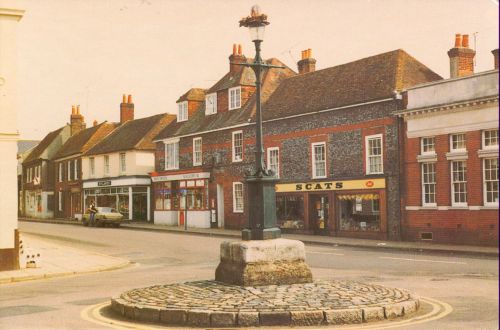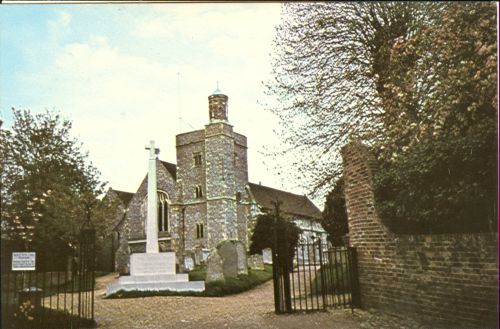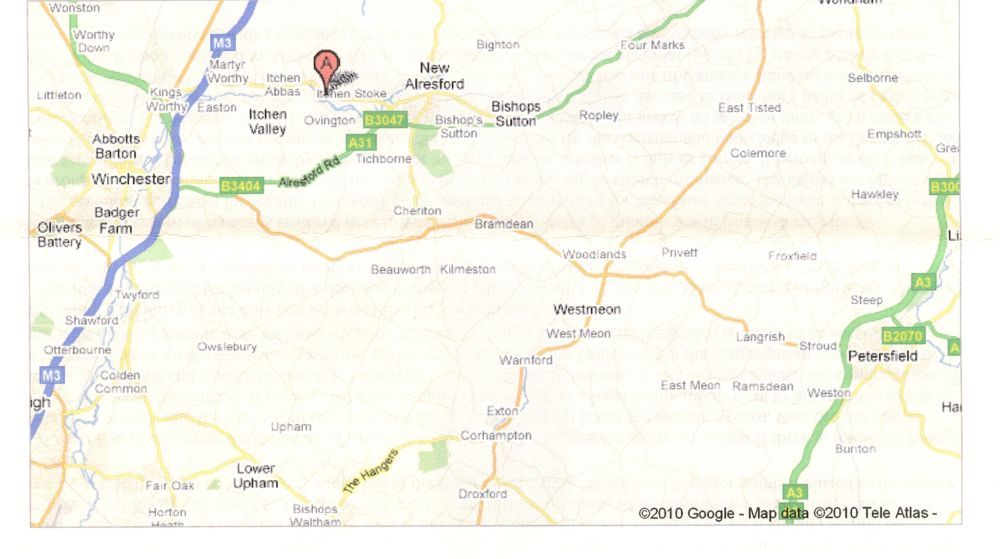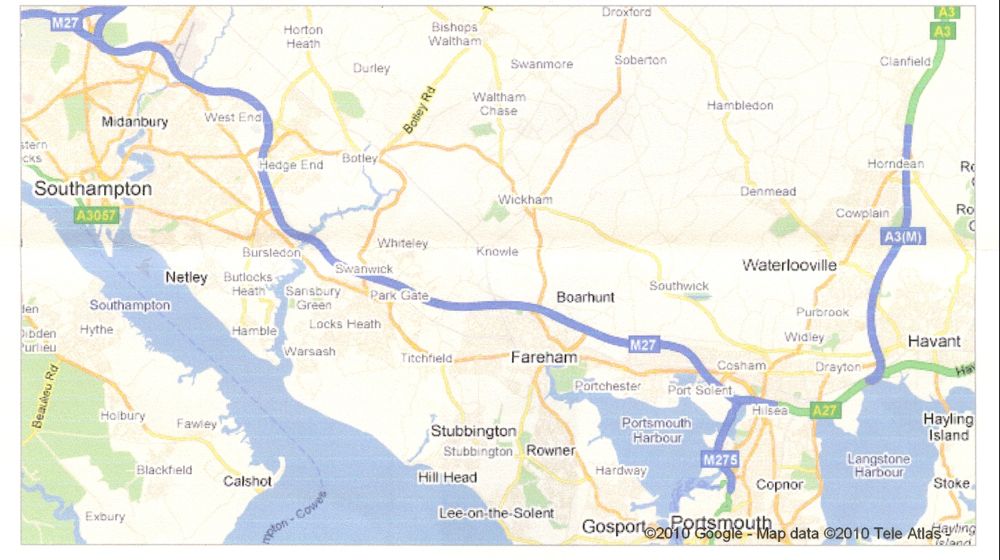Hampshire is the home of the Titheridges, so it seems appropriate to know something of this county of origin, especially for our fellow genealogists who live abroad.
Hampshire is a county of south central England. It has been populated since early times and there is evidence of prehistoric settlements of most ages present. Winchester is the focal point of the road system built by the Romans. The county is first mentioned in the Anglo Saxon Chronicle in 755 AD when Winchester was an important town.
The county has always been agricultural, the main concerns being dairy farming,production of corn and market gardening. There is still a large acreage of woodland. Portsmouth and Gosport form one of Britain's principal naval centres and Southampton is a major passenger port. Tourism is also important, while market towns also have light industries such as engineering.
Visits to the villages reveal the agricultural nature of the area. The villages are beautiful and many of the villages give the impression of stepping back in time. They are full of old cottages, some still with old thatched roofs. In all villages, the old village church forms a distinctive landmark centre piece of the village.
A few of the smaller villages are little more than a handful of cottages built near the large manor house and church. It seems natural that our agricultural forbearers would work the land for the wealthy landowners who lived at the manor houses, moving from village to village as necessary to find work.
Below is summarised some information on most of the Hampshire villages and towns that play an important role in the Titheridge history.
John Tidridge is unsure of the protocol surrounding google maps, but he readily admits that is where they are taken from. While most of the villages are on the map; those missing can be 'filled in' by doing a little imaginary travelling.
ALVERSTOKE
Situated 21 miles SE of Winchester, it is on the coast on the opposite side of Portsmouth Harbour to Portsmouth. The parish church of St. Mary has records dating from 1559. It is the home of the Haslar naval hospital which was built between 1746 and 1762.
AVINGTON
Situated 3.5 miles NE of Winchester, it has the River Itchen flowing nearby. It is an area rich with trees, meadows, charming cottages and gardens. Avington house in a fine red brick mansion with a lake and park. The parish church of St. Mary has records dating from 1610, although the present church was built around 1770. It is a red brick building and shows stateliness inside and is a fine example of an eighteenth century place of worship.
BASINGSTOKE
Situated 17.5 miles NE of Winchester, the River Lodden flows nearby before joining the Thames. The older parish church of St. Michael has records dating from 1638. This is now a busy town
BIGHTON
Situated 9 miles SE of Winchester, it has an old parish church of All Saints with records dating from 1573. The church has some parts dating from the thirteenth century, a fifteenth century bell and a Norman font and windows.
|
High Street, Bishops Waltham
|
St. Peter's Church, Bishops Waltham
|
 |
 |
The photos from postcards, noted above, were sent by Roy Daysh a relative of whom married a Titheridge a couple of generations ago. Roy carried out the initial research into John Tidridge's family tree. He did an excellent & thorough job
BISHOPS WALTHAM
Situated 9 miles SE of Winchester, the River Hamble flows nearby. The village has narrow streets with old fashioned houses. The parish church of St. Peter is a fine church that stands high above the town. The tower dates from 1582 and the porch from 1613. The parish records date from 1612. The Bishops of Winchester had a noble palace and park land there. The palace was begun in 1136 by Henry de Blois and finished in the fifteenth century by William Wykeham. The ruins of the palace still remain. During the Napoleonic wars French prisoners were kept in the village.
BRAMDEAN
Situated 8.5 miles E of Winchester, it is the place where the River Itchen rises. The parish church of St. Simon and St. Jude is 700 hundred years old with a wooden bellcot. It has records dating from 1573. The village has delightful old houses and was the site where an old Roman house was found.
CHERITON
Situated 6.5 miles E of Winchester, it is an entrancing village full of lovely old cottages and situated in the shallow valley of the Itchen. On top of a green hill is the parish church of St. Michael and All Angels. The church was first built 700 hundred years ago but it has since been rebuilt, although it still retains a twelfth century tower and fourteenth century carvings. It has records dating from 1557. A feature of Cheriton is a group of mounds where the dead from the battle of Cheriton in 1644 were buried. At Cheriton Wood armies of 10000 men met and endured stubborn fighting before the Royalists finally defeated the Parliamentarians with heavy casualties.
CHILCOMBE
Situated below the downs 2 miles E of Winchester, it has timbered houses and tall trees. The parish church of St. Andrew is Norman and has records dating from 1556.
DROXFORD
Situated 10.5 miles SE of Winchester, it is on the River Meon. The parish church of St. Mary and All Saints was largely restored in the nineteenth century, although it has a fifteenth century tower.. It has records dating from 1633. The railway station was used as the D-Day headquarters by Winston Churchill and the War Cabinet.
EAST MEON
Situated 13.5 miles SE of Winchester, it has the River Moen flowing through it. The village has interesting old cottages in rich meadows of the winding valley, with chalky hills around the village covered with lovely trees. The parish church of All Saints dates back 800 hundred years and has a famous font made of black marble of Tournai. It has records dating from 1560. There are remains of an old court house that is a lovely medieval manor in which the Bishops of Winchester held court.
EAST TISTED
Situated 14 miles E of Winchester, it consists of charming houses and gardens situated along the Alton Road. The parish church of St. James was built in the nineteenth century to replace an old one. It has records dating from 1561. Across the road from the church is Rotherfield Park mansion and a few miles along the road is Pelham House.
KILMESTON
Situated 7 miles east of Winchester, it consists of a small number of houses and the manor house. The parish church of St. Andrew has records dating from 1661.
KINGCLERE
Situated 18.5 miles N of Winchester, it is a sleepy village in splendid down land. The parish church of St. Mary has records dating from 1538 and although the outside of the church is new, the inside is old.
NEW ALRESFORD
Situated 7 miles NE of Winchester, the River Itchen flows through one end of town. It is a trim prosperous looking county town which was founded in 1189 by Godfrey de Lucy, Bishop of Winchester. He built a dam on the Itchen between Old and New Alresford and built a reservoir into which the river Arle flows, in the hope of making the Itchen navigable from Alresford to Southampton. in all seasons. In the seventeenth and eighteenth centuries the town was several times destroyed by fire. After the fire of 1763 the town was almost completely rebuilt. The parish church of St. John the Baptist also suffered a plague of fires and had to be rebuilt but a few old Norman bits remain. It has records dating from 1678. The village has charming houses situated behind lime trees. Broad Street is one of the old streets that has two grass verges and it lined with little old shops.
OLD ALRESFORD
Situated 7.5 miles NE of Winchester, it has a sedgy green divided by a trickling stream. The parish church of St. Mary has records dating from 1556. It is a brick building dating from the eighteenth century. Mary Summers, the founder of the Mothers Union was the vicar's wife here.
PORTSMOUTH
Situated 22 miles SE of Winchester on the coast, it is one of the greatest naval ports in the world. Portsmouth and Gosport face each other across the harbour. A lot of Portsmouth is relatively new having been rebuilt after the World War II. There is still a part of old Portsmouth remaining., mainly around the naval dockyard area, which was the area which originally formed Portsea. The old area has narrow streets, Georgian houses, the garrison church, and the Cathedral (Portsmouth St. Thomas). Within the naval dockyard are the historic ships of HMS Victory, Nelson's flagship at the battle of Trafalgar; HMS Warrior an iron battleship built in 1860 and the Mary Rose, Henry VIII's warship sunk in 1545 and raised from the sea bed in 1982. There are thirty parish church in Portsmouth, with the earliest records from 1654 at Portsea St. Mary and Portsmouth St. Thomas.
SOUTHAMPTON
Situated 12.5 miles SW of Winchester, it is a great port on an inlet of the coast called Southampton Water. To the right of the town the River Test joins the sea and to the left the River Itchen joins the sea. The town has some medieval walls and three ancient gateways. Within the walls Southampton is rich in old houses. Southampton has thirty-three parish churches, with the oldest of these being St. Michael in the heart of the old town. The old churches of Holy Rood and All Saints were both war casualties.
SWANMORE
Situated 10 miles SE of Winchester, it has the parish church of St. Barnabas with records dating from 1845.
WEST MEON
Situated 10.5 miles SE of Winchester, it has the River Meon flowing through the town. It is full of charming villages situated in a charming green valley. The parish church of the St. John the Evangelist is a flint church that was rebuilt in the last century, but has a beautiful old church yard. It has records dating from 1536.
WEST TISTED
Situated 14 miles E of Winchester, it is at the end of a track and consists of a few houses, a manor house and a little grey church. The parish church of Mary Magdalene has parish records dating from 1538. The church has a Norman font and a roof 700 hundred years old. In the graveyard is a beautiful old yew tree. Also in the village is the hollow oak tree where Sir Benjamin Tichbourne hid from the Royalists in 1644.
WINCHESTER
Winchester has been a town since the time of the Romans. It is a town steeped in history. It is full of old houses, old hospitals and a castle, ancient gateways such as the west gate 600 years old, an ancient cross, a statue of King Alfred, quaint passages and cloistered ways, a great town wall and a famous old public school. The magnificent medieval cathedral has dominated the scene for 800 years. As well as Winchester Cathedral, whose records stretch back to 1599, Winchester has about thirteen parish churches, four of them have records going as far back as 1560-1570.
contributed by Mike and Ann Titheradge
In June 2010 John Tidridge added the maps of (most) the appropriate parts of Hampshire

